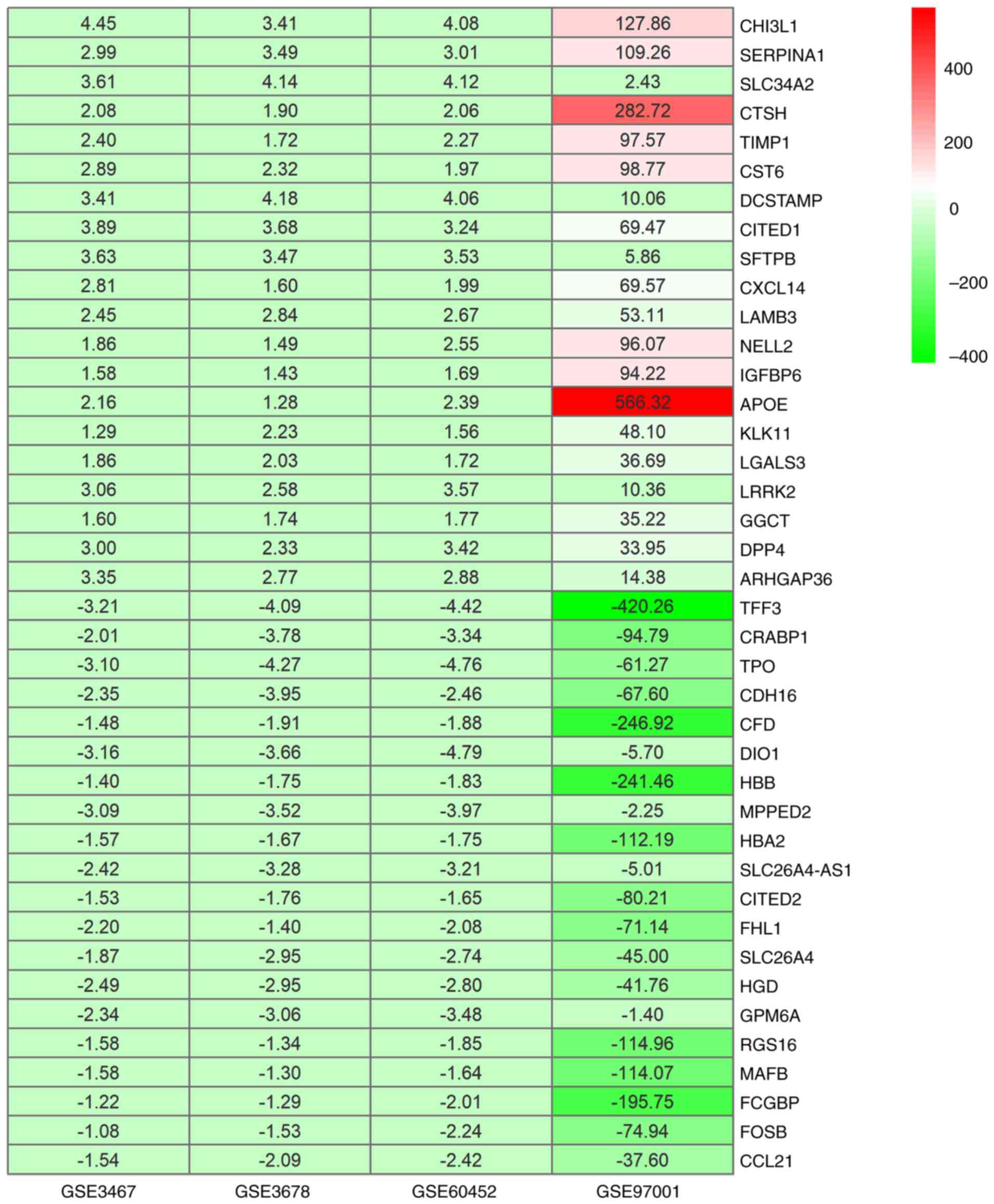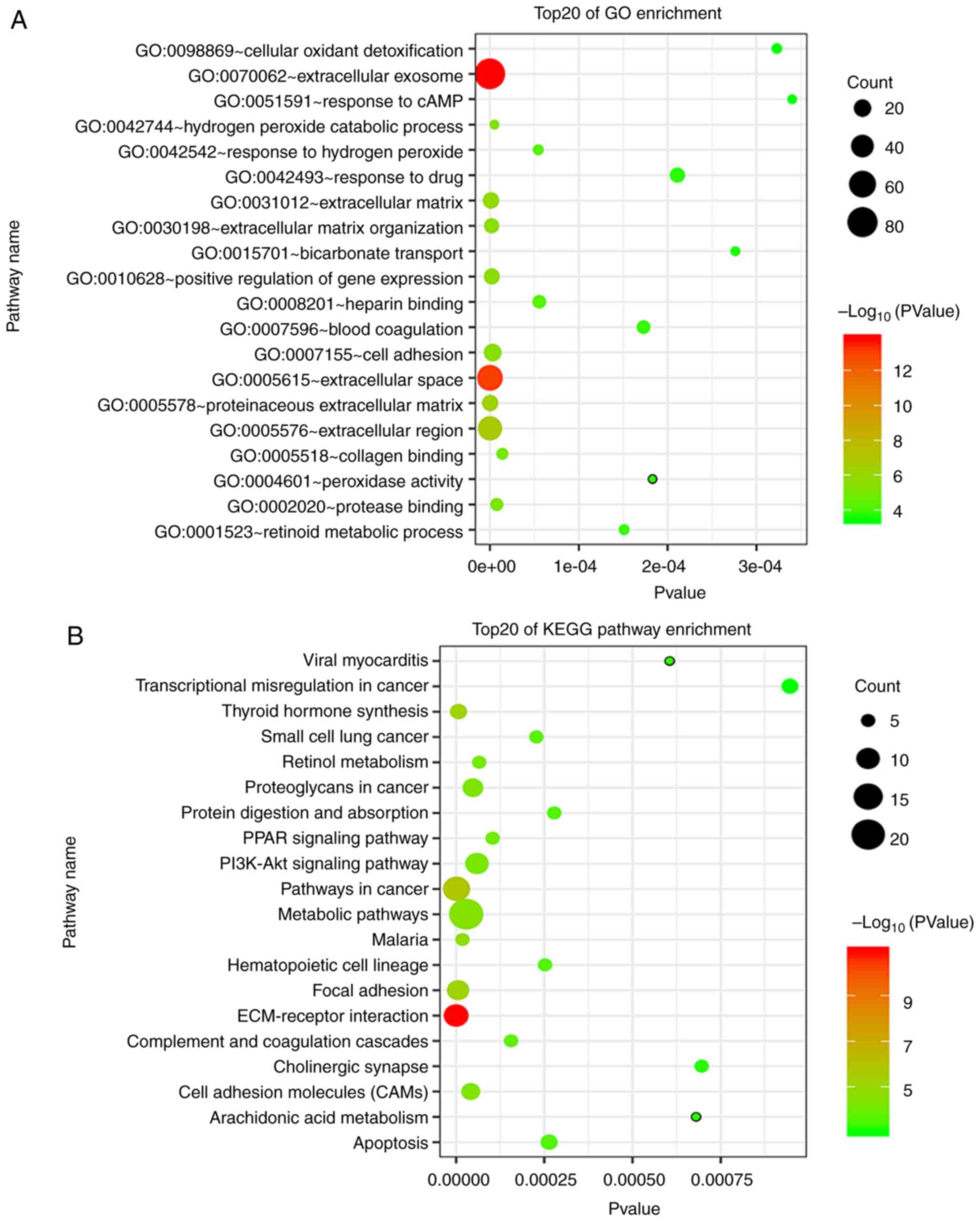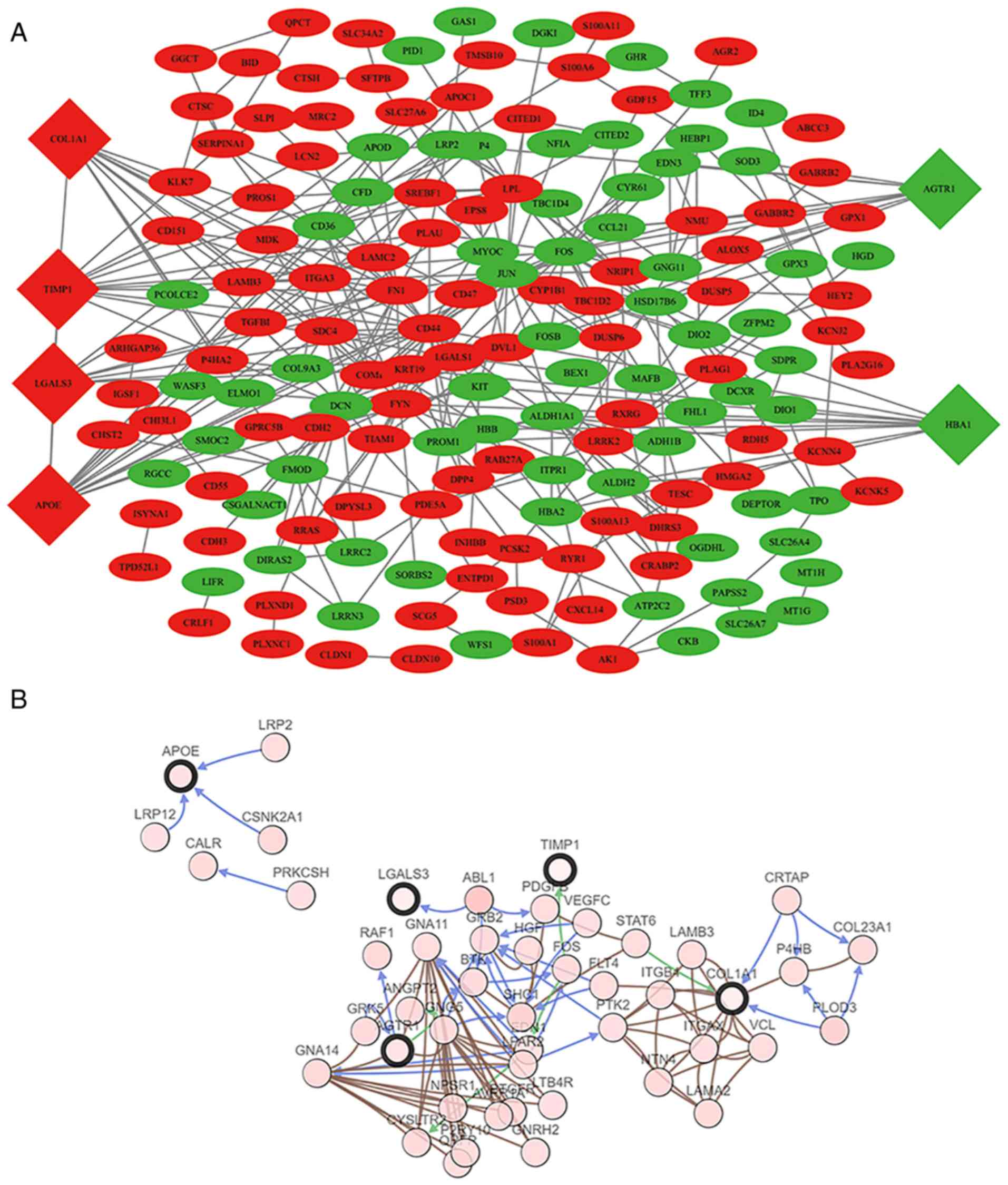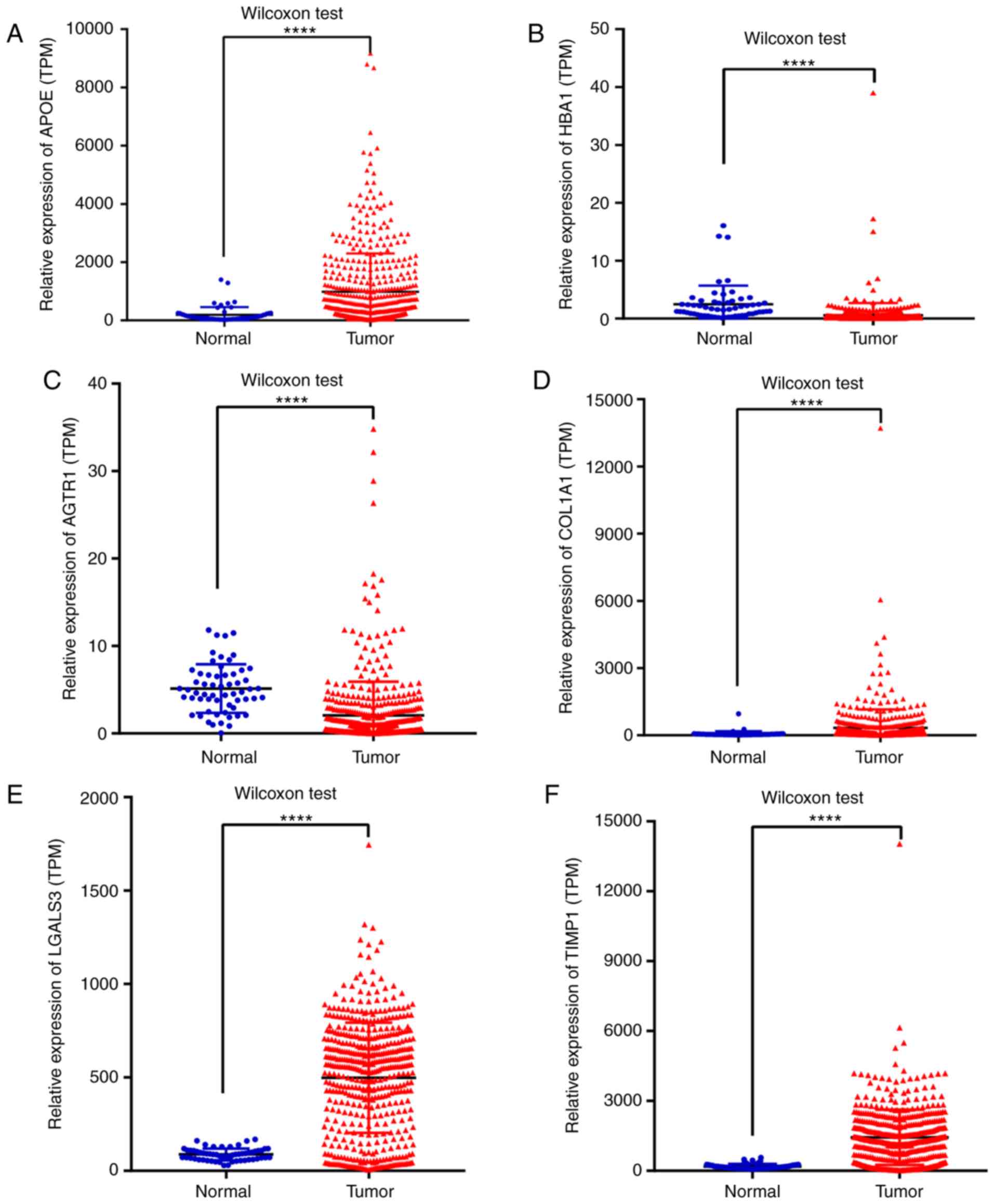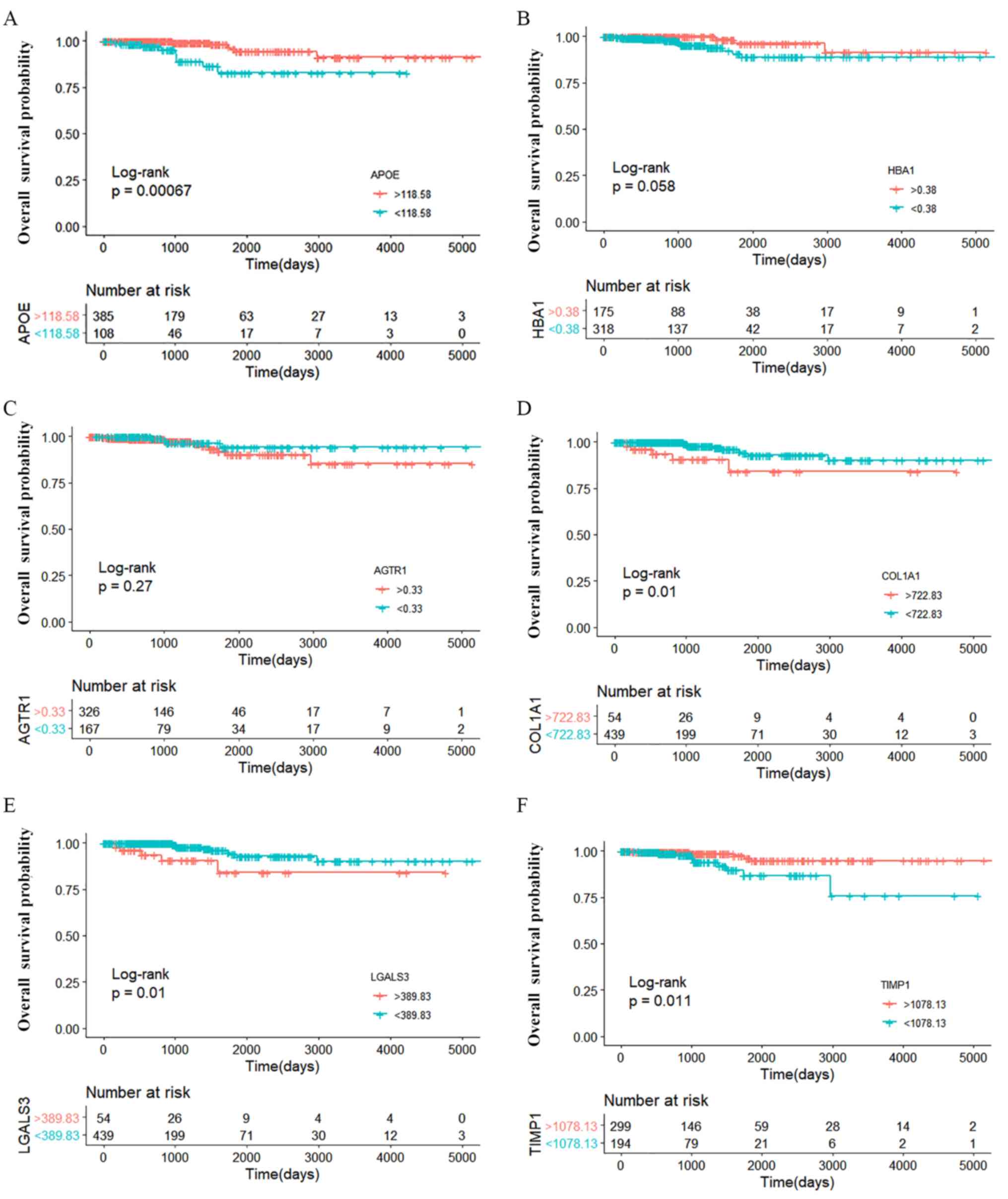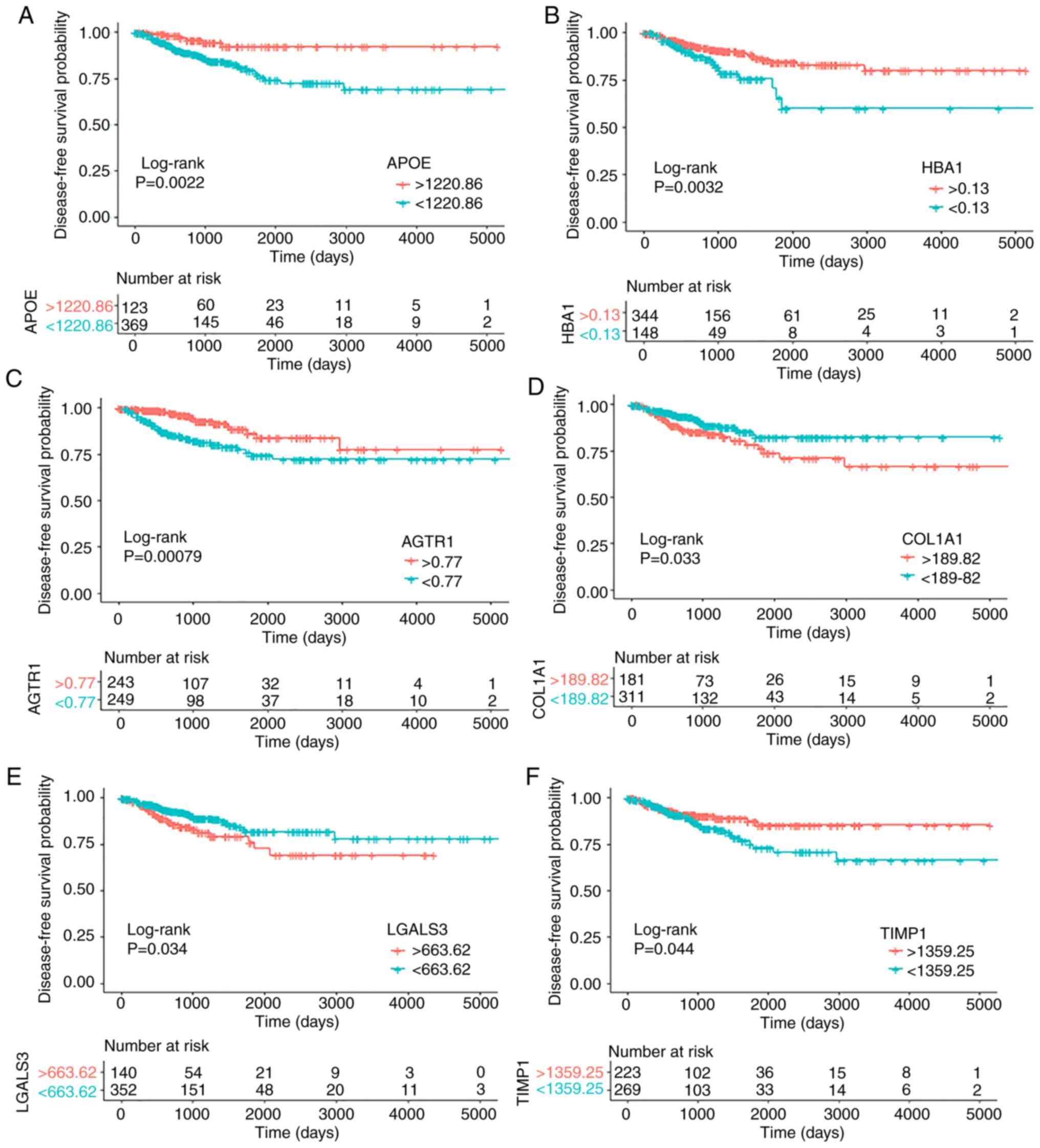Papillary thyroid carcinoma (PTC) is one of the most
prevalent thyroid malignancies; the morbidity and mortality ranks
ninth and sixth, respectively, with 567,000 new cases diagnosed and
41,000 cancer-related deaths in 2018, worldwide (1). In recent years, the widespread
application of thyroid ultrasonography and ultrasound-guided fine
needle aspiration has improved the diagnosis of PTC in an
asymptomatic population (2). Most
patients have PTC that is curable, with a 5-year survival rate
>95%. However, a few cases of PTC might occur with invasive
features such as tumor recurrence, cervical lymph node involvement
and/or distant metastasis, which are associated with poor prognosis
(3,4). Therefore, biomarkers that can predict
poor outcomes are urgently needed as these would assist clinicians
in taking early and appropriate measures for optimal therapeutic
benefit.
Current studies have indicated the involvement of
various molecular events in the deterioration of PTC (5,6),
including BRAF and RAS mutations, rearrangements of RET
protooncogene and the excessive activation of the mitogen-activated
protein kinase signal transduction pathway (7–10). To
date, multiple microRNAs (miRs) and long non-coding RNAs (lncRNAs)
have been identified as potential molecular biomarkers, including
miR-146b-5p and lncRNA HOTTIP, which have been confirmed to
participate in the invasion and metastasis of PTC (11–14).
Nevertheless, the majority of these findings are derived from
preclinical studies, and large-scale studies of prognostic
biomarkers of PTC are lacking.
The development of bioinformatic analysis and the
emergence of public database sorting have facilitated the
identification of prognostic biomarkers of multiple types of cancer
based on large cohorts, including kinesin family member 4A for
colorectal cancer (15), miR-106a in
breast cancer (16) and kirre-like
nephrin family adhesion molecule 1 in melanoma (17). In the present study, the Gene
Expression Omnibus (GEO) database (18) was used to mine differentially
expressed genes (DEGs) between PTC tissues and adjacent normal
tissues of PTC. Subsequently, multiple bioinformatics methods,
including Gene Ontology (GO) and Kyoto Encyclopedia of Genes and
Genome (KEGG) enrichment analysis, construction of a
protein-protein interaction (PPI) network and network topological
analysis were employed to identify hub genes in DEGs which
potentially related to the initiation and progression of PTC. In
addition, association of the expression of hub genes with prognosis
as well as clinical stage of patients with PTC was validated using
The Cancer Genome Atlas (TCGA) database and survival analysis.
To assess the potential molecular mechanisms of DEGs
in PTC, the Database for Annotation, Visualization and Integrated
Discovery (DAVID) online tool (23)
was utilized for GO analysis (24)
to annotate genes and to define the functions of DEGs into 3
domains: Cellular component, biological process and molecular
function. Subsequently, KEGG enrichment analysis was conducted to
understand the signaling pathways in which DEGs genes were involved
(25).
Clinical data and RNA-sequencing data on patients
with thyroid cancer were downloaded from TCGA database (29). There were 510 thyroid cancer (THCA)
samples and 58 normal samples in the TCGA-THCA cohort. Pathological
classifications of non-papillary carcinoma specimens were first
excluded, and samples with pathological parameters and follow-up
data remained, leaving 493 patients with PTC and 58 normal thyroid
samples. Additionally, the expression value of the RNA sequencing
data, downloaded as transcripts per million (TPM), was analyzed.
The coexpression network of hub genes was identified base on STRING
network and CytoScape software was in cBioportal (http://www.cbioportal.org/).
R software version 3.4.2 (R Foundation) or GraphPad
Prism version 7.0 software (GraphPad, Inc.) were used for
statistical analysis. The differential expression of hub genes
between normal and PTC tissue were analysed using the Wilcoxon
test, and the Kaplan-Meier curves and log-rank test were used for
survival analysis of hub genes. P<0.05 was considered to
indicate a statistically significant difference. The ‘Survminer’
package (https://cran.r-project.org/web/packages/survminer/index.html)
for R was applied to determine the optimal cut-off value to divide
patients into 2 groups based on either high or low gene expression,
based on receiver operating characteristic. Pearson's χ2
test or Fisher's exact test were employed to determine the
association between DEGs and clinicopathological characteristics of
patients with PTC. Moreover, overall survival (OS) and disease-free
survival (DFS) were calculated using the R package survival
(https://cran.r-project.org/web/packages/survival/index.html).
The cut-off value of significant GO terms and KEGG pathway was
P<0.05. Univariate Cox proportional hazard models were utilized
to explore the prognostic value of the significant DEGs.
Subsequently, multivariate Cox regression was used for the
identification of independent predictors of PTC.
GO is considered as the international standard
classification system for gene function. A total of 240 DEGs were
identified. As shown in Fig. 2A,
‘Cellular oxidant detoxification’, ‘extracellular exosome’, ‘cell
adhesion’, ‘extracellular matrix’, ‘collagen binding’ and ‘protease
binding’ was enrichment based on GO analysis. KEGG analysis was
undertaken using the DAVID tool, which revealed the most
significantly enriched pathways included thyroid hormone synthesis,
pathways in cancer, focal adhesion, metabolic pathways, apoptosis
and the PPAR and PI3K/AKT signaling pathways in KEGG (Fig. 2B).
A PPI network of DEGs was first constructed using
the STRING database, followed by data visualization by Cytoscape
(Fig. 3A). To further mine the
significant nodes in the network, topological analysis of each node
was performed using the Cytoscape plugin cytoHubba. The 6 most
significant genes identified in the PPI network were apolipoprotein
E (APOE), hemoglobin subunit α1 (HBA1), angiotensin II receptor
type 1 (AGTR1), collagen type I α1 (COL1A1), galectin 3 (LGALS3)
and TIMP metallopeptidase inhibitor 1 (TIMP1). The co-expression
network of these 6 hub genes based on the TCGA-THCA cohort dataset
was constructed using the cBioportal tool (http://www.cbioportal.org/) (Fig. 3B).
A total of 493 patients with PTC and 58 normal
thyroid samples were identified in the TCGA-THCA dataset. To
validate the reliability of the 6 significant genes identified in
the GEO database, the expression level of these genes was assessed
in the TCGA database by including 493 PTC samples and 58 normal
thyroid tissues. As shown in Fig. 4,
the expression trends of these genes were in line with previous GEO
analysis (Fig. 1). To identify the
association between the 6 hub genes and prognosis for patients with
PTC, samples from the TCGA database were further categorized into
high and low expression groups. As shown in Fig. 5, the expression levels of 4 genes,
APOE, COL1A1, LGALS3 and TIMP1, were significantly associated with
OS. As shown in Fig. 6, all 6
significant genes were associated with DFS in patients with PTC.
Among these genes, APOE had the most significant association with
OS (P=0.00067) and DFS (P=0.00220), suggesting that APOE may play a
critical role in PTC progression and is significantly associated
with prognosis.
To further demonstrate the importance of APOE in PTC
and patient prognosis, the association of APOE expression with
clinicopathological features of patients with PTC was analyzed
using the TCGA dataset. As presented in Table II, low expression of APOE was
significantly associated with older age (P<0.001) and more
advanced TNM stage (P<0.001). The results revealed that gender,
lymph node involvement, distant metastasis and cancer multifocality
were not significantly associated with APOE expression. Finally,
univariate and multivariate Cox proportional hazard analyses were
conducted. As shown in Table III,
univariate analysis revealed that the mRNA expression of APOE
(P=0.002) was closely associated with TNM stage (P=0.001), while
multivariate analysis suggested that APOE could be an independent
prognostic factor for patients with PTC.
PTC is the most prevalent malignancy in the
endocrine system, with a rapid increase in morbidity rate in past
two decades (1). Despite the
relatively good 5-year survival rate of patients with PTC, tumor
recurrence and lymph node metastasis are common, which might impact
the OS and DFS of patients with PTC (30,31).
In the present study, DEGs between neoplastic and
adjacent tissues of PTC were analyzed using the GEO database.
Consequently, 134 upregulated and 106 downregulated DEGs were
identified. GO and KEGG enrichment analysis, establishment of PPI
network and network topological analysis were utilized to identify
genes potentially related to the initiation and development of PTC.
It can be hypothesized that most of the DEGs identified in the
present study were enriched in multiple cancer initiation and
development-related pathological processes and signaling pathways
based on GO and KEGG enrichment analysis from previous research
(32–37). Recent evidence from network biology
suggests that genes and proteins do not function in isolation.
Instead, they function in interconnected pathways and molecular
networks on multiple levels (38).
In a previous study the properties and behavior of biological
molecules were also identified using the PPI network, suggesting
this is an important tool (39).
In total, 6 significant hub genes were identified
among the DEGs: APOE, HBA1, AGTR1, COL1A1, LGALS3 and TIMP1. Of
these 6 genes, HBA1, AGTR1, COL1A1 and TIMP1 have previously been
reported to participate in the pathogenesis, development, malignant
transformation and pathological process of PTC, and they have been
significantly associated with patient survival and prognosis
(40–43). These previous studies have confirmed
the reliability and accuracy of the bioinformatic mining results in
the present study.
APOE is a well-known apolipoprotein that functions
in lipoprotein-mediated lipid transport between organs via the
plasma and interstitial fluids (44). As a secreted protein, APOE has been
implicated in lipoprotein metabolism and the pathogenesis of
Alzheimer's disease and atherosclerosis (45–47).
However, its association with tumors has rarely been reported. In
recent years, an additional role of APOE has been identified in the
pathogenesis of tumor metastasis (48,49).
APOE can inhibit the invasiveness of melanoma cells and the
recruitment of endothelial cells, potentially functioning as a
vital barrier to metastatic colonization (50,51).
APOE has also been demonstrated to be involved in innate immune
modulation, which could be a target to enhance the efficacy of
cancer immunotherapy in patients (52). Moreover, the abnormal expression of
APOE in lung, colorectal and gastric cancer has been reported
(53–56); however, the association between APOE
and PTC has not been investigated and should be the basis of future
research.
At present, the association of the expression of
numerous genes with the survival of patients with PTC is
increasingly being mined. The majority of present studies are
validated in animal tumor models, in vitro cell models or
small-scale clinical studies (57,58).
However, large-scale studies with more comprehensive analysis and
larger cohorts are required due to the complexity of PTC.
Fortunately, the rapid development of genome-wide sequencing has
led to the development of publicly-available high-throughput tumor
databases such as GEO and TCGA, which have made it possible to
conduct bioinformatic analysis of large datasets of patients with
PTC.
Not applicable.
The present study was supported by the Youth Fund of
the Second Affiliated Hospital to Nanchang University (grant no.
2016YNQN12026) and the Young and Middle-aged Doctor Research
Project of the Thyroid Gland from China Health Promotion Foundation
and the Natural Science Foundation in China (grant nos.
81660294,.81560397 and 81660403, respectively).
YXL and QGJ designed the study. QGJ and WQF
collected and analyzed the data. YXL drafted, wrote and critically
revised the manuscript. CFX analyzed the data. YXL critically
revised the manuscript. All authors had intellectual input into the
study and approved the final version of the manuscript.
Not applicable.
Not applicable.
The authors declare that they have no competing
interests.
|
1
|
Bray F, Ferlay J, Soerjomataram I, Siegel
RL, Torre LA and Jemal A: Global cancer statistics 2018: GLOBOCAN
estimates of incidence and mortality worldwide for 36 cancers in
185 countries. CA Cancer J Clin. 68:394–424. 2018. View Article : Google Scholar : PubMed/NCBI
|
|
2
|
Xing M, Haugen BR and Schlumberger M:
Progress in molecular-based management of differentiated thyroid
cancer. Lancet. 381:1058–1069. 2013. View Article : Google Scholar : PubMed/NCBI
|
|
3
|
Rusinek D, Pfeifer A, Krajewska J,
Oczko-Wojciechowska M, Handkiewicz-Junak D, Pawlaczek A,
Zebracka-Gala J, Kowalska M, Cyplinska R, Zembala-Nozynska E, et
al: Coexistence of TERT promoter mutations and the BRAF V600E
alteration and its impact on histopathological features of
papillary thyroid carcinoma in a selected series of polish
patients. Int J Mol Sci. 19:E26472018. View Article : Google Scholar : PubMed/NCBI
|
|
4
|
Kwak HY, Chae BJ, Eom YH, Hong YR, Seo JB,
Lee SH, Song BJ, Jung SS and Bae JS: Does papillary thyroid
carcinoma have a better prognosis with or without Hashimoto
thyroiditis? Int J Clin Oncol. 20:463–473. 2015. View Article : Google Scholar : PubMed/NCBI
|
|
5
|
Selmansberger M, Feuchtinger A, Zurnadzhy
L, Michna A, Kaiser JC, Abend M, Brenner A, Bogdanova T, Walch A,
Unger K, et al: CLIP2 as radiation biomarker in papillary thyroid
carcinoma. Oncogene. 34:3917–3925. 2015. View Article : Google Scholar : PubMed/NCBI
|
|
6
|
Liu Z, Cai J, Yu Y, Fang H, Si Y, Jankee
JJ and Shen M: Tumor abnormal protein as a novel biomarker in
papillary thyroid carcinoma. Clin Lab. 63:479–485. 2017. View Article : Google Scholar : PubMed/NCBI
|
|
7
|
Giordano TJ, Kuick R, Thomas DG, Misek DE,
Vinco M, Sanders D, Zhu Z, Ciampi R, Roh M, Shedden K, et al:
Molecular classification of papillary thyroid carcinoma: Distinct
BRAF, RAS, and RET/PTC mutation-specific gene expression profiles
discovered by DNA microarray analysis. Oncogene. 24:6646–6656.
2005. View Article : Google Scholar : PubMed/NCBI
|
|
8
|
Ciampi R, Knauf JA, Kerler R, Gandhi M,
Zhu Z, Nikiforova MN, Rabes HM, Fagin JA and Nikiforov YE:
Oncogenic AKAP9-BRAF fusion is a novel mechanism of MAPK pathway
activation in thyroid cancer. J Clin Invest. 115:94–101. 2005.
View Article : Google Scholar : PubMed/NCBI
|
|
9
|
Crescenzi A, Guidobaldi L, Nasrollah N,
Taccogna S, Cicciarella Modica DD, Turrini L, Nigri G, Romanelli F,
Valabrega S, Giovanella L, et al: Immunohistochemistry for
BRAF(V600E) antibody VE1 performed in core needle biopsy samples
identifies mutated papillary thyroid cancers. Horm Metab Res.
46:370–374. 2014. View Article : Google Scholar : PubMed/NCBI
|
|
10
|
Clinkscales W, Ong A, Nguyen S, Harruff EE
and Gillespie MB: Diagnostic value of RAS mutations in
indeterminate thyroid nodules. Otolaryngol Head Neck Surg.
156:472–479. 2017. View Article : Google Scholar : PubMed/NCBI
|
|
11
|
Fagin JA and Wells SA Jr: Biologic and
clinical perspectives on thyroid cancer. N Engl J Med.
375:23072016. View Article : Google Scholar : PubMed/NCBI
|
|
12
|
Lima CR, Geraldo MV, Fuziwara CS, Kimura
ET and Santos MF: MiRNA-146b-5p upregulates migration and invasion
of different Papillary Thyroid Carcinoma cells. BMC Cancer.
16:1082016. View Article : Google Scholar : PubMed/NCBI
|
|
13
|
Condello V, Torregrossa L, Sartori C,
Denaro M, Poma AM, Piaggi P, Valerio L, Materazzi G, Elisei R,
Vitti P and Basolo F: mRNA and miRNA expression profiling of
follicular variant of papillary thyroid carcinoma with and without
distant metastases. Mol Cell Endocrinol. 479:93–102. 2019.
View Article : Google Scholar : PubMed/NCBI
|
|
14
|
Chen F, Yin S, Zhu J, Liu P, Yang C, Feng
Z and Deng Z: lncRNA DGCR5 acts as a tumor suppressor in papillary
thyroid carcinoma via sequestering miR-2861. Exp Ther Med.
17:895–900. 2019.PubMed/NCBI
|
|
15
|
Matsumoto Y, Saito M, Saito K, Kanke Y,
Watanabe Y, Onozawa H, Hayase S, Sakamoto W, Ishigame T, Momma T,
et al: Enhanced expression of KIF4A in colorectal cancer is
associated with lymph node metastasis. Oncol Lett. 15:2188–2194.
2018.PubMed/NCBI
|
|
16
|
Liu C, Song YH, Mao Y, Wang HB and Nie G:
MiRNA-106a promotes breast cancer progression by regulating DAX-1.
Eur Rev Med Pharmacol Sci. 23:1574–1583. 2019.PubMed/NCBI
|
|
17
|
Lundgren S, Fagerstrom-Vahman H, Zhang C,
Ben-Dror L, Mardinoglu A, Uhlen M, Nodin B and Jirström K:
Discovery of KIRREL as a biomarker for prognostic stratification of
patients with thin melanoma. Biomark Res. 7:12019. View Article : Google Scholar : PubMed/NCBI
|
|
18
|
Edgar R, Domrachev M and Lash AE: Gene
Expression Omnibus: NCBI gene expression and hybridization array
data repository. Nucleic Acids Res. 30:207–210. 2002. View Article : Google Scholar : PubMed/NCBI
|
|
19
|
He H, Jazdzewski K, Li W, Liyanarachchi S,
Nagy R, Volinia S, Calin GA, Liu CG, Franssila K, Suster S, et al:
The role of microRNA genes in papillary thyroid carcinoma. Proc
Natl Acad Sci USA. 102:19075–19080. 2005. View Article : Google Scholar : PubMed/NCBI
|
|
20
|
Tarabichi M, Saiselet M, Tresallet C,
Hoang C, Larsimont D, Andry G, Maenhaut C and Detours V: Revisiting
the transcriptional analysis of primary tumours and associated
nodal metastases with enhanced biological and statistical controls:
Application to thyroid cancer. Br J Cancer. 112:1665–1674. 2015.
View Article : Google Scholar : PubMed/NCBI
|
|
21
|
Iacobas DA, Tuli NY, Iacobas S, Rasamny
JK, Moscatello A, Geliebter J and Tiwari RK: Gene master regulators
of papillary and anaplastic thyroid cancers. Oncotarget.
9:2410–2424. 2017.PubMed/NCBI
|
|
22
|
Diboun I, Wernisch L, Orengo CA and
Koltzenburg M: Microarray analysis after RNA amplification can
detect pronounced differences in gene expression using limma. BMC
Genomics. 7:2522006. View Article : Google Scholar : PubMed/NCBI
|
|
23
|
Dennis G Jr, Sherman BT, Hosack DA, Yang
J, Gao W, Lane HC and Lempicki RA: DAVID: Database for annotation,
visualization, and integrated discovery. Genome Biol. 4:P32003.
View Article : Google Scholar : PubMed/NCBI
|
|
24
|
Ashburner M, Ball CA, Blake JA, Botstein
D, Butler H, Cherry JM, Davis AP, Dolinski K, Dwight SS, Eppig JT,
et al: Gene ontology: Tool for the unification of biology. The gene
ontology consortium. Nat Genet. 25:25–29. 2000. View Article : Google Scholar : PubMed/NCBI
|
|
25
|
Kanehisa M, Furumichi M, Tanabe M, Sato Y
and Morishima K: KEGG: New perspectives on genomes, pathways,
diseases and drugs. Nucleic Acids Res. 45:D353–D361. 2017.
View Article : Google Scholar : PubMed/NCBI
|
|
26
|
Szklarczyk D, Morris JH, Cook H, Kuhn M,
Wyder S, Simonovic M, Santos A, Doncheva NT, Roth A, Bork P, et al:
The STRING database in 2017: Quality-controlled protein-protein
association networks, made broadly accessible. Nucleic Acids Res.
45:D362–D368. 2017. View Article : Google Scholar : PubMed/NCBI
|
|
27
|
Chin CH, Chen SH, Wu HH, Ho CW, Ko MT and
Lin CY: cytoHubba: Identifying hub objects and sub-networks from
complex interactome. BMC Syst Biol. 8 (Suppl 4):S112014. View Article : Google Scholar : PubMed/NCBI
|
|
28
|
Tan J, Qian X, Song B, An X, Cai T, Zuo Z,
Ding D, Lu Y and Li H: Integrated bioinformatics analysis reveals
that the expression of cathepsin S is associated with lymph node
metastasis and poor prognosis in papillary thyroid cancer. Oncol
Rep. 40:111–122. 2018.PubMed/NCBI
|
|
29
|
Asa SL, Giordano TJ and LiVolsi VA:
Implications of the TCGA genomic characterization of papillary
thyroid carcinoma for thyroid pathology: Does follicular variant
papillary thyroid carcinoma exist? Thyroid. 25:1–2. 2015.
View Article : Google Scholar : PubMed/NCBI
|
|
30
|
Wang K, Xu J, Li S, Liu S and Zhang L:
Population-based study evaluating and predicting the probability of
death resulting from thyroid cancer among patients with papillary
thyroid microcarcinoma. Cancer Med. 8:6977–6985. 2019. View Article : Google Scholar : PubMed/NCBI
|
|
31
|
Londero SC, Krogdahl A, Bastholt L,
Overgaard J, Pedersen HB, Hahn CH, Bentzen J, Schytte S,
Christiansen P, Gerke O, et al: Papillary thyroid carcinoma in
Denmark, 1996–2008: Outcome and evaluation of established
prognostic scoring systems in a prospective national cohort.
Thyroid. 25:78–84. 2015. View Article : Google Scholar : PubMed/NCBI
|
|
32
|
Rappa G, Puglisi C, Santos MF, Forte S,
Memeo L and Lorico A: Extracellular vesicles from thyroid
carcinoma: The New Frontier of Liquid Biopsy. Int J Mol Sci.
20:E11142019. View Article : Google Scholar : PubMed/NCBI
|
|
33
|
Andriescu EC, Caruntu ID, Giusca SE,
Lozneanu L and Ciobanu Apostol DG: Prognostic significance of
cell-adhesion molecules in histological variants of papillary
thyroid carcinoma. Rom J Morphol Embryol. 59:721–727.
2018.PubMed/NCBI
|
|
34
|
Tang T and Zhang DL: Study on
extracellular matrix metalloproteinase inducer and human epidermal
growth factor receptor-2 protein expression in papillary thyroid
carcinoma using a quantum dot-based immunofluorescence technique.
Exp Ther Med. 9:1331–1335. 2015. View Article : Google Scholar : PubMed/NCBI
|
|
35
|
Selemetjev S, Bartolome A, Isic Dencic T,
Đorić I, Paunović I, Tatić S and Cvejić D: Overexpression of
epidermal growth factor receptor and its downstream effector, focal
adhesion kinase, correlates with papillary thyroid carcinoma
progression. Int J Exp Pathol. 99:87–94. 2018. View Article : Google Scholar : PubMed/NCBI
|
|
36
|
Arts RJ, Plantinga TS, Tuit S, Ulas T,
Heinhuis B, Tesselaar M, Sloot Y, Adema GJ, Joosten LA, Smit JW, et
al: Transcriptional and metabolic reprogramming induce an
inflammatory phenotype in non-medullary thyroid carcinoma-induced
macrophages. Oncoimmunology. 5:e12297252016. View Article : Google Scholar : PubMed/NCBI
|
|
37
|
French CA, Fletcher JA, Cibas ES,
Caulfield C, Allard P and Kroll TG: Molecular detection of PPAR
gamma rearrangements and thyroid carcinoma in preoperative
fine-needle aspiration biopsies. Endocr Pathol. 19:166–174. 2008.
View Article : Google Scholar : PubMed/NCBI
|
|
38
|
Miryala SK, Anbarasu A and Ramaiah S:
Discerning molecular interactions: A comprehensive review on
biomolecular interaction databases and network analysis tools.
Gene. 642:84–94. 2018. View Article : Google Scholar : PubMed/NCBI
|
|
39
|
Wang S, Wang H and Lu Y: Tianfoshen oral
liquid: A CFDA approved clinical traditional Chinese medicine,
normalizes major cellular pathways disordered during colorectal
carcinogenesis. Oncotarget. 8:14549–14569. 2017.PubMed/NCBI
|
|
40
|
Wasenius VM, Hemmer S, Kettunen E,
Knuutila S, Franssila K and Joensuu H: Hepatocyte growth factor
receptor, matrix metalloproteinase-11, tissue inhibitor of
metalloproteinase-1, and fibronectin are up-regulated in papillary
thyroid carcinoma: A cDNA and tissue microarray study. Clin Cancer
Res. 9:68–75. 2003.PubMed/NCBI
|
|
41
|
Qiu J, Zhang W, Xia Q, Liu F, Li L, Zhao
S, Gao X, Zang C, Ge R and Sun Y: RNA sequencing identifies crucial
genes in papillary thyroid carcinoma (PTC) progression. Exp Mol
Pathol. 100:151–159. 2016. View Article : Google Scholar : PubMed/NCBI
|
|
42
|
Hawthorn L, Stein L, Varma R, Wiseman S,
Loree T and Tan D: TIMP1 and SERPIN-A overexpression and TFF3 and
CRABP1 underexpression as biomarkers for papillary thyroid
carcinoma. Head Neck. 26:1069–1083. 2004. View Article : Google Scholar : PubMed/NCBI
|
|
43
|
Lin P, Guo YN, Shi L, Li XJ, Yang H, He Y,
Li Q, Dang YW, Wei KL and Chen G: Development of a prognostic index
based on an immunogenomic landscape analysis of papillary thyroid
cancer. Aging (Albany NY). 11:480–500. 2019. View Article : Google Scholar : PubMed/NCBI
|
|
44
|
Verghese PB, Castellano JM, Garai K, Wang
Y, Jiang H, Shah A, Bu G, Frieden C and Holtzman DM: ApoE
influences amyloid-β (Aβ) clearance despite minimal apoE/Aβ
association in physiological conditions. Proc Natl Acad Sci USA.
110:E1807–E1816. 2013. View Article : Google Scholar : PubMed/NCBI
|
|
45
|
Zokaei N, Cepukaityte G, Board AG, Mackay
CE, Husain M and Nobre AC: Dissociable effects of the
apolipoprotein-E (APOE) gene on short- and long-term memories.
Neurobiol Aging. 73:115–122. 2019. View Article : Google Scholar : PubMed/NCBI
|
|
46
|
Zheng L, Duan J, Duan X, Zhou W, Chen C,
Li Y, Chen J, Zhou W, Wang YJ, Li T and Song W: Association of
Apolipoprotein E (ApoE) polymorphism with Alzheimer's disease in
Chinese population. Curr Alzheimer Res. 13:912–917. 2016.
View Article : Google Scholar : PubMed/NCBI
|
|
47
|
Weber C and Soehnlein O: ApoE controls the
interface linking lipids and inflammation in atherosclerosis. J
Clin Invest. 121:3825–3827. 2011. View Article : Google Scholar : PubMed/NCBI
|
|
48
|
An HJ, Koh HM and Song DH: Apolipoprotein
E is a predictive marker for assessing non-small cell lung cancer
patients with lymph node metastasis. Pathol Res Pract.
215:1526072019. View Article : Google Scholar : PubMed/NCBI
|
|
49
|
Zhao Z, Zou S, Guan X, Wang M, Jiang Z,
Liu Z, Li C, Lin H, Liu X, Yang R, et al: Apolipoprotein E
overexpression is associated with tumor progression and poor
survival in colorectal cancer. Front Genet. 9:6502018. View Article : Google Scholar : PubMed/NCBI
|
|
50
|
LXR agonism inhibits metastatic melanoma
through activation of ApoE. Cancer Discov. 4:OF162014. View Article : Google Scholar
|
|
51
|
Pencheva N, Tran H, Buss C, Huh D,
Drobnjak M, Busam K and Tavazoie SF: Convergent multi-miRNA
targeting of ApoE drives LRP1/LRP8-dependent melanoma metastasis
and angiogenesis. Cell. 151:1068–1082. 2012. View Article : Google Scholar : PubMed/NCBI
|
|
52
|
Tavazoie MF, Pollack I, Tanqueco R,
Ostendorf BN, Reis BS, Gonsalves FC, Kurth I, Andreu-Agullo C,
Derbyshire ML, Posada J, et al: LXR/ApoE activation restricts
innate immune suppression in cancer. Cell. 172:825–840.e18. 2018.
View Article : Google Scholar : PubMed/NCBI
|
|
53
|
Tahmasbpour E, Ghanei M and Panahi Y: Two
lung cancer development-related genes, Forkhead Box M1 (FOXM1) and
Apolipoprotein E (APOE), are overexpressed in Bronchial of patients
after long-term exposure to Sulfur Mustard. Iran J Pharm Res.
16:1487–1494. 2017.PubMed/NCBI
|
|
54
|
Liu Z, Gao Y, Hao F, Lou X, Zhang X, Li Y,
Wu D, Xiao T, Yang L, Li Q, et al: Secretomes are a potential
source of molecular targets for cancer therapies and indicate that
APOE is a candidate biomarker for lung adenocarcinoma metastasis.
Mol Biol Rep. 41:7507–7523. 2014. View Article : Google Scholar : PubMed/NCBI
|
|
55
|
Sakashita K, Tanaka F, Zhang X, Mimori K,
Kamohara Y, Inoue H, Sawada T, Hirakawa K and Mori M: Clinical
significance of ApoE expression in human gastric cancer. Oncol Rep.
20:1313–1319. 2008.PubMed/NCBI
|
|
56
|
Slattery ML, Sweeney C, Murtaugh M, Ma KN,
Potter JD, Levin TR, Samowitz W and Wolff R: Associations between
apoE genotype and colon and rectal cancer. Carcinogenesis.
26:1422–1429. 2005. View Article : Google Scholar : PubMed/NCBI
|
|
57
|
Liu F, Zhang J, Qin L, Yang Z, Xiong J,
Zhang Y, Li R, Li S, Wang H, Yu B, et al: Circular RNA EIF6
(Hsa_circ_0060060) sponges miR-144-3p to promote the
cisplatin-resistance of human thyroid carcinoma cells by autophagy
regulation. Aging (Albany NY). 10:3806–3820. 2018. View Article : Google Scholar : PubMed/NCBI
|
|
58
|
Jia M, Shi Y, Li Z, Lu X and Wang J:
MicroRNA-146b-5p as an oncomiR promotes papillary thyroid carcinoma
development by targeting CCDC6. Cancer Lett. 443:145–156. 2019.
View Article : Google Scholar : PubMed/NCBI
|















